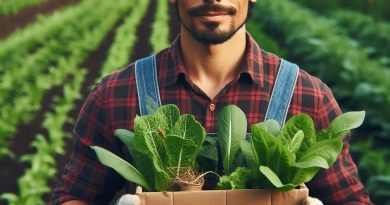Organic Trials: One Farmer’s Shift Story
Last Updated on March 1, 2024
Introduction
Farmer Organic Trials, embarking on the path of organic farming isn’t merely a change in agricultural methods; it’s a transformative journey, filled with challenges, discoveries, and profound shifts in mindset.
In this section, we intimately explore the narrative of a farmer who dared to take this leap of faith.
Understanding Organic Farming
Organic farming stands as a testament to harmony with nature.
It rejects the conventional use of synthetic pesticides, herbicides, and fertilizers in favor of natural alternatives like compost, crop rotation, and biological pest control.
By nurturing the soil’s health and biodiversity, organic farming not only produces wholesome, chemical-free food but also fosters ecological balance and sustainability.
The Purpose of this Blog Post
The essence of this blog post is to share the authentic experiences of a farmer navigating the labyrinthine path of transitioning to organic farming.
We aim not just to provide information but to offer a narrative that resonates with fellow farmers, aspiring agriculturists, and conscientious consumers alike.
Through this farmer’s story, we delve into the complexities, triumphs, and tribulations inherent in the organic shift.
Our protagonist’s journey serves as a microcosm of the broader movement towards sustainable agriculture.
By documenting their trials, tribulations, and ultimate triumphs, we hope to shed light on the realities faced by those who dare to challenge conventional farming practices.
From battling pest infestations without chemical pesticides to rejuvenating depleted soils through organic amendments, every step of the transition is a testament to resilience and dedication.
Furthermore, this blog post seeks to inspire and educate, offering insights into the practical aspects of organic farming while also delving into the philosophical underpinnings that drive this movement.
By sharing the intimate details of one farmer’s shift towards organic practices, we aim to foster a deeper understanding of the challenges and rewards that accompany such a profound change.
Ultimately, our goal is to empower readers to embark on their own journeys towards a more sustainable and harmonious relationship with the land.
Background of the Farmer
Name and Location of the Farmer
- Environmental Concerns: He witnessed the adverse impact of chemical inputs on the soil, water, and biodiversity.
- Health Consciousness: John became increasingly aware of the potential health risks associated with consuming food produced with synthetic chemicals.
- Demand for Organic Products: As the demand for organic produce skyrocketed, John saw an opportunity for economic growth.
Realizing the need for change, John decided to transition his farming practices from conventional to organic.
He understood that this shift would not be easy as it required a complete overhaul of his farming methods.
John began by educating himself about organic farming techniques, attending workshops, and connecting with other organic farmers.
He learned about soil health, crop rotation, composting, and the use of natural pest control methods.
John gradually reduced the use of chemical inputs and started implementing organic alternatives, promoting a more sustainable approach to farming.
Previous Farming Experiences and Practices
One of the main challenges John faced during this transition was weed control.
Without the use of herbicides, he had to resort to manual labor and implement strategies like mulching and cover cropping.
Though labor-intensive, John realized the long-term benefits of this shift outweighed the initial difficulties.
Over time, John witnessed significant improvements on his farm.
The soil texture improved, as its natural fertility was restored through organic matter accumulation and reduced erosion.
The biodiversity on his farm flourished, with an abundance of beneficial insects, birds, and pollinators.
John noticed that his crops had a richer flavor and better shelf life, making them more appealing to consumers.
As the demand for organic produce continued to rise, John’s farm became a thriving business.
Local markets, grocery stores, and even restaurants began sourcing their organic produce from John’s farm.
Motivation behind the Shift towards Organic Farming
John’s success story inspired many other farmers in his region to consider shifting towards organic farming.
He became an advocate for sustainable agriculture, sharing his experiences and knowledge with fellow farmers.
John firmly believes that organic farming not only benefits the environment and human health but also ensures a prosperous future for farming communities.
Through his journey, John has proven that with determination and a willingness to change, organic farming can be a viable and rewarding alternative to conventional methods.
His farm stands as a testimony to the vast potential of sustainable agriculture in creating a healthier planet for future generations.
Read: Blossoming Organically: A Family Farm’s Tale
Challenges Encountered
Initial skepticism and resistance from the farming community
- The farmer faced initial skepticism and resistance from fellow farmers in the community.
- Many farmers were hesitant to embrace organic farming methods due to lack of awareness.
- The farmer had to overcome the notion that organic farming was less profitable and more labor-intensive.
- Convincing the farming community to adopt organic practices required patience and persistence.
- The farmer organized workshops and seminars to educate others about the benefits of organic farming.
- Gradually, the skepticism started to diminish, and some farmers began showing interest in organic methods.
- The farmer actively engaged with the farming community, sharing success stories and offering support.
- Building trust and fostering open discussions helped to overcome the initial skepticism faced.
- Over time, more farmers started transitioning to organic farming, contributing to a supportive network.
- The farmer was relieved to witness a shift in the mindset of the farming community towards organic practices.
Transitioning from conventional to organic farming methods
- Shifting from conventional to organic farming methods was a significant challenge for the farmer.
- The farmer had to relearn and adapt to new techniques and practices rooted in organic principles.
- Training sessions and guidance from experienced organic farmers played a vital role in the transition.
- Understanding the importance of soil health and biodiversity was crucial during the shift.
- Crop rotation, composting, and natural pest control methods had to be implemented effectively.
- The farmer had to let go of chemical fertilizers, pesticides, and herbicides, which required a change in mindset.
- Patience was key as it took time for the soil ecosystem to adjust and regain its natural balance.
- The farmer faced challenges in finding organic alternatives for pest control and disease management.
- Experimentation and trial and error helped in identifying the most effective organic farming techniques.
- Despite the initial difficulties, the farmer embraced the transition and experienced the long-term benefits of organic farming.
Dealing with the impact on crop production and yield
- Switching to organic farming methods initially resulted in a decrease in crop production and yield.
- The farmer had to contend with lower crop yields due to the absence of synthetic fertilizers and chemicals.
- However, the farmer remained determined to prioritize long-term sustainability over short-term gains.
- Continuous monitoring of soil health and nutrient levels allowed for adjustments in organic farming practices.
- Natural methods to enhance soil fertility, such as cover cropping and crop rotation, were adopted.
- Despite lower yields, the farmer noticed improvements in the overall quality of the harvest.
- Organic crops were found to have better taste, texture, and nutritional value, appealing to consumers.
- The farmer explored organic market channels and found a niche for organic produce, despite the lower quantity.
- Over time, the farmer discovered techniques to improve soil fertility and increase crop yields organically.
- The challenges faced during the transition period ultimately led to a more sustainable and resilient farming system.
Read: Green Fields: An Organic Cotton Tale

Strategies and Solutions
By conducting thorough research and embracing education, organic farmers can stay ahead of emerging trends and challenges.
Collaboration with fellow farmers and organizations fosters a sense of community and enables the exchange of valuable knowledge and resources.
Implementing crop rotation, cover cropping, and natural pest control methods is crucial for sustainable and environmentally friendly farming practices.
Research and education on organic farming practices
Research and education play a vital role in organic farming.
Farmers need to stay informed about the latest advancements, techniques, and scientific studies in organic agriculture.
Engaging in continuous learning through workshops, conferences, and online resources ensures that farmers are equipped with the knowledge and skills to optimize their organic farming practices.
Collaboration with other organic farmers and organizations
Collaboration is key in the organic farming community.
By forming partnerships with other organic farmers, farmers can learn from each other’s experiences and share valuable insights.
Joining organic farming associations and networks provides a platform for knowledge exchange, support, and collective advocacy.
Collaborating with agricultural organizations allows farmers to tap into additional resources, guidance, and assistance.
Implementation of crop rotation, cover cropping, and natural pest control methods
Implementing crop rotation, cover cropping, and natural pest control methods are essential components of organic farming practices.
Crop rotation helps maintain soil health by alternating different crop varieties, breaking pest and disease cycles, and replenishing soil nutrients.
By planting cover crops such as legumes, farmers can prevent soil erosion, suppress weeds, enhance soil fertility, and provide habitat for beneficial insects.
Natural pest control methods, including biological control agents, organic insecticides, and trap crops, reduce reliance on synthetic pesticides and promote a healthier ecosystem.
Integrated pest management strategies involve monitoring pest populations, using cultural practices, and employing biological controls to minimize the use of chemicals and maintain a balance between pests and beneficial insects.
In fact, organic farmers can adopt strategies and solutions to enhance their farming practices and promote sustainable agriculture.
Research and education enable farmers to stay informed and adapt to new developments.
Collaboration with fellow farmers and organizations provides support and resources.
Implementing crop rotation, cover cropping, and natural pest control methods ensures the long-term viability of organic farming while protecting the environment.
Read: Mothers & Harvest: Balancing Family and Farms
Find Out More: Beekeeping on a Budget: A Farmer’s Tale
Results and Changes
Improved soil health and fertility over time
The shift to organic farming practices has led to significant improvements in soil health and fertility on my farm.
By avoiding the use of synthetic fertilizers and pesticides, the soil ecosystem has become more balanced and resilient.
Organic methods, such as crop rotation, cover cropping, and composting, have helped replenish nutrients, promote beneficial microbial activity, and enhance the overall structure of the soil.
This has resulted in increased productivity and the ability to grow healthier crops.
Over the years, I have noticed that my soil has become richer and more alive.
It is now teeming with earthworms, beneficial insects, and microorganisms, which are essential for nutrient cycling and plant growth.
This positive change in soil health has been one of the most rewarding outcomes of my shift to organic farming.
Reduction in the use of synthetic fertilizers and pesticides
Another significant change I have experienced is the substantial reduction in the use of synthetic fertilizers and pesticides on my farm.
Prior to transitioning to organic, I heavily relied on these chemical inputs to control pests and enhance crop yields.
However, I soon realized that the excessive use of synthetic chemicals not only harmed the environment but also disrupted the natural balance of the ecosystem.
It led to the development of pesticide-resistant pests and compromised the health of beneficial insects.
Through the adoption of organic practices, I have been able to minimize the reliance on synthetic inputs.
Instead, I have embraced integrated pest management techniques, such as biological controls and companion planting, which have proven to be effective in pest control without causing harm to the environment.
Positive impact on biodiversity and ecosystem health
The shift to organic farming has had a remarkable positive impact on biodiversity and ecosystem health on my farm.
By eliminating the use of harmful chemicals, I have created a more favorable environment for diverse plant and animal species.
The presence of hedgerows, wildflower strips, and cover crops has provided habitat and food sources for beneficial insects, birds, and pollinators.
This has resulted in a noticeable increase in the diversity and abundance of wildlife on my farm.
Moreover, the absence of chemical residues in the soil and water has contributed to the overall health and resilience of the ecosystem.
The natural balance has been restored, and I have witnessed a revival of native plants, improved water quality, and a thriving ecosystem.
Shift in market demand and the farmer’s economic sustainability
One of the most significant changes I have experienced as a result of transitioning to organic farming is the shift in market demand and its positive impact on my economic sustainability.
As consumers become more aware of the benefits of organic produce and the impact of conventional agriculture on human health and the environment, there has been a growing demand for organic products.
This market shift has allowed me to fetch premium prices for my organic crops.
In addition, organic farming has helped me reduce input costs by minimizing the purchase of expensive synthetic fertilizers and pesticides.
Instead, I have adopted cost-effective organic alternatives, such as homemade compost and natural pest control methods.
By diversifying my crops and embracing organic practices, I have become less reliant on external inputs, reducing the financial risks associated with fluctuating market prices and input costs.
This has contributed to the overall economic sustainability of my farm.
In short, the results and changes I have witnessed in my farming journey towards organic practices have been immensely positive.
Improved soil health, reduced reliance on synthetic inputs, enhanced biodiversity, and the economic benefits have made the shift worthwhile.
Organic farming not only provides a sustainable and healthier way of producing food, but it also nurtures the land and contributes to the preservation of our planet’s delicate ecosystems.
Read: Harvesting Health: One Farm’s Organic Path
Lessons Learned
Importance of patience and perseverance during the transition process
- Transitioning to organic farming requires patience and perseverance.
- It is not an overnight process but a long-term commitment.
- There will be challenges along the way, but staying dedicated is crucial.
- Patience is needed when waiting for the soil to regenerate naturally.
- It takes time for the ecosystem to restore its balance and develop a healthy microbiome.
- Perseverance is necessary to overcome setbacks and never give up.
- It may feel discouraging at times, but the rewards outweigh the struggles.
- Transitioning farmers must remind themselves of their ultimate goal and stay focused.
- With patience and perseverance, the organic shift becomes a rewarding journey.
The significance of continuous learning and adapting practices
- Organic farming is a dynamic field that continually evolves with new knowledge and techniques.
- Transitioning farmers need to prioritize continuous learning and staying up to date.
- Attending workshops, conferences, and webinars help expand knowledge and keep informed.
- Reading books and scientific studies gives valuable insights into best practices.
- Experimentation and observation are crucial for finding the most effective methods.
- Adapting practices based on findings leads to improved crop yields and soil fertility.
- Being open-minded and flexible allows farmers to embrace innovation and adjust accordingly.
- Never being complacent and always seeking improvement benefits the entire organic community.
- Continuous learning is the key to progress in the ever-changing field of organic farming.
Building a supportive network of farmers and organizations
- No farmer should embark on the organic shift journey alone.
- Building a supportive network of like-minded farmers is invaluable.
- Sharing experiences, challenges, and success stories fosters growth and inspiration.
- Joining local organic farming associations creates networking opportunities.
- Collaborating with established organic farmers provides mentorship and guidance.
- Farmers should actively participate in community events and workshops.
- Engaging with organizations advocating for organic agriculture offers support and resources.
- Benefitting from the knowledge and experience of others accelerates the learning process.
- A strong network of farmers and organizations strengthens the organic farming community.
Transitioning to organic farming requires patience, perseverance, continuous learning, and a supportive network.
It is a challenging yet fulfilling journey, where each lesson learned contributes to the success of the organic shift.
By staying dedicated, adapting practices, and connecting with fellow farmers and organizations,
farmers can build a sustainable and thriving organic farming future for themselves and the planet.
Conclusion
Recap of the Farmer’s Journey
The farmer’s organic transition was challenging but rewarding.
They faced obstacles like soil health and pest control.
Despite challenges, they persevered, adopting sustainable practices.
They embraced natural methods, shunning synthetic inputs and chemicals.
Acknowledgment of Long-term Benefits
Over time, the farmer noticed profound changes.
Soil fertility improved, teeming with beneficial microbes.
Biodiversity flourished, attracting pollinators and natural predators.
Crop resilience soared, reducing dependence on external inputs.
Encouragement to Other Farmers
To fellow farmers contemplating organic farming, take the leap.
Embrace the journey towards sustainability.
Yes, challenges will arise, but so will opportunities.
The earth will thank you, and so will future generations.
In general, the farmer’s shift to organic farming wasn’t easy.
They faced numerous challenges, from soil health to pest control, but they persevered, adopting sustainable practices.
Over time, they observed significant benefits, including improved soil fertility, increased biodiversity, and enhanced crop resilience.
To other farmers considering a shift towards organic farming, the message is clear: embrace the journey towards sustainability.
Despite the challenges, the rewards are immense, not just for the earth but also for future generations.


